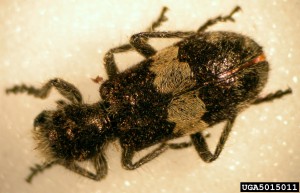Posted December 15, 2014
By SHAWNA KHALAFI
The state of Colorado is known for its breathtaking scenery: majestic purple mountains and abundant green forests; however, those forests are rapidly becoming less and less green and abundant, all thanks to a tiny insect called the mountain pine beetle.
After infesting the tree, the pine beetles release a blue dye that turns the tree to a purple/maroon color and eventually kills the tree altogether.
According to the U.S. Department of Agriculture, “more than 1.5 million acres of forest in northern Colorado and southern Wyoming are affected by the mountain pine beetle epidemic” and the beetle have now killed nearly all of the mature lodge pole trees in those areas.

The pine beetle (Photo courtesy of U.S. Dept. of Agriculture Forest Service, Rocky Mountain Region Archive).
There are three main factors currently fueling the mountain pine beetle epidemic in Colorado.
First, the large number of forest stands with high tree densities make Colorado especially susceptible to mountain pine beetles.
Another factor that is contributing to the pine beetle outbreak is the lack of moisture. Colorado has experienced mild to severe drought conditions consistently since the late 1990s. This lack of moisture in the air weakens and stresses the trees, making them prime targets for the mountain pine beetles to attack.
The final, and possibly most alarming, contributing factor is the absence of “cold” winters in recent years. Since mountain pine beetles are unable to survive in extreme cold temperatures, the fact that Colorado has been experiencing higher than normal winter temperatures for the past 10 years especially troubling.
Alysha Buckman, a Denver resident and Colorado native, agrees this issue is definitely recognized a constant concern for all residents of Colorado.
“Every winter we’re all wishing for two things: snow and cold temperatures. We just need one cold wave to kill off those pests and get rid of them for good, and people know that. Everybody wants to keep Colorado beautiful, so we try to contribute in any way we can,” Buckman stated.
Click on the video above to view an audio slide show about the pine beetles problem in Colorado prepared by writer Shawna Khalafi.
Others argue that the severity of this issue is not being properly acknowledged or recognized by those in positions of power.
“Just because a lot of us don’t see the effects every day doesn’t mean it’s not happening. It’s like people just brush it off as a problem that will fix itself; like it’s Mother Nature’s problem and not ours,” said Colorado resident Phaedra Wilkins. “We created this mess, so it would be irresponsible of us to walk away from it now and let our children clean it up for us in the future.”
Homeowners in the mountain regions of Colorado are especially effected by the pine beetle outbreaks.
“It’s just not what you want to see when you look out of your window in the morning,” said Shawn Aryana, a Breckenridge, Colo., homeowner and realtor. “It’s affected my personal life and caused my business to take a huge hit, especially in the past three or four years.”
In addition to ruining scenic views, the pine beetle epidemic also has an effect on many other crucial things including watersheds, timber productions, wildlife habitats, recreation sites, and transmission lines.
The large amount of dead trees remaining in many areas in Colorado are also cause for concern as they could likely spark catastrophic wild fires. David Cunningham, of the Rocky Mountain Division of the Beetle Incident Management Organization, stressed the need for immediate action regarding the pine beetle problem.
“We all remember the High Park fire in the summer of 2012. Even though pine beetles have been attacking the Rocky Mountain region at epidemic levels for almost a decade, that fire was a wake-up call to people that this is more than a problem of insect infestation; this is a real threat to the health and well-being of both our forests and our loved ones,” Cunningham stated.
Former firefighter Larry Goodman offered more insight into the devastating wild fire in 2012.
“All it took was one lightning strike to spark that whole fire. As a result of years of pine beetle attacks, there were lots of dried-up, dead trees in that area which is the perfect ingredient to fuel a fire of that capacity. It’s important to get to the root of this problem, which is obviously the pine beetle attacks, and stop the cause,” he explained.
Residents of the affected areas are trying to stay positive as new approaches are being implemented to help slow the outbreaks, but so far no solution has been found to the massive pine beetle epidemic in Colorado and southern Wyoming.
